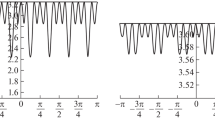Abstract
Gompertz functions have been widely used in characterizing biological growth curves. In this paper we consider D-optimal designs for Gompertz regression models. For homoscedastic Gompertz regression models with two or three parameters, we prove that D-optimal designs are minimally supported. Considering that minimally supported designs might not be applicable in practice, alternative designs are proposed. Using the D-optimal designs as benchmark designs, these alternative designs are found to be efficient in general.
Similar content being viewed by others
References
Atkinson A.C., Donev A.N., Tobias R. (2007) Optimum Experimental Designs, with SAS. Oxford University Press, Oxford
Chaloner K., Larntz K. (1989) Optimal Bayesian design applied to logistic regression experiments. Journal of Statistical Planning and Inference 21: 191–208
Chaloner K., Verdinelli I. (1995) Bayesian experimental design: a review.. Statistical Science 10: 273–304
Chernoff H. (1953) Locally optimal design for estimating parameters. Annals of Mathematical Statistics 24: 586–602
Dette, H., Melas, V. B., Wong, W.K. (2006). Locally D-optimal designs for exponential regression. Statistica Sinica, 16, 789–803.
Fedorov V.V., Hackle P. (1997) Model-Oriented Design of Experiments. Springer, New York
Ford I., Torsney B., Wu C.F.J. (1992) The use of a canonical form in the construction of locally optimal designs for non-linear problems. Journal of the Royal Statistical Society Series B 54: 569–583
Gompertz B. (1825) On the nature of the function expressive of the law of human mortality, and on a new mode of determining the value of life contigencies. Philosophical Transactions B 115: 513–585
Han C., Chaloner K. (2003) D- and c-optimal designs for exponential regression models used in viral dynamics and other applications. Journal of Statistical Planning and Inference 115: 585–601
Hedayat A., Yan B., Pezzuto J.M. (1997) Modeling and identifying optimum designs for fitting dose-response curves based on raw optical density data.. Journal of the American Statistical Association, 92(1132–1140): 92 1132–1140
Karlin S., Studden W.J. (1966) Tchebyschev Systems: With Applications in Analysis and Statistics. Wiley, New York
Kiefer J., Wolfowitz J. (1960) The equivalence of two extremum problems. Canadian Journal of Mathematics 12: 363–366
Laird K. A. (1965) Dynamics of tumour growth: comparison of growth rates and extrapolation of growth curve to one cell. British Journal of Cancer 19: 278–291
Li G., Majumdar D. (2008) D-optimal designs for logistic models with three and four parameters. Journal of Statistical Planning and Inference 138: 1950–1959
Li G., Majumdar D. (2009) Some results on D-optimal designs for nonlinear models with applications. Biometrika 96: 487–493
Marusic M., Vuk-Pavlovic S. (1993) Prediction power of mathematical models for tumor growth. Journal of Biological System 1: 69–78
Melas V.B. (2006) Functional approach to optimal experimental design. In Lecture notes in statistics (Vol. 184). Springer, New York
Sitter R.R., Wu C.F.J. (1993) Optimal designs for binary response experiments.. Scandinavian Journal of Statistics 20: 329–341
White L. (1973) An extension of the general equivalence theorem to nonlinear models. Biometrika 60: 345–348
Yang M. (2010) On the de la Garza Phenomenon. Annals of Statistics 38: 2499–2524
Yang M., Stufken J. (2009) Support points of locally optimal designs for nonlinear models with two parameters. Annals of Statistics 37: 518–541
Author information
Authors and Affiliations
Corresponding author
About this article
Cite this article
Li, G. Optimal and efficient designs for Gompertz regression models. Ann Inst Stat Math 64, 945–957 (2012). https://doi.org/10.1007/s10463-011-0340-y
Received:
Revised:
Published:
Issue Date:
DOI: https://doi.org/10.1007/s10463-011-0340-y




